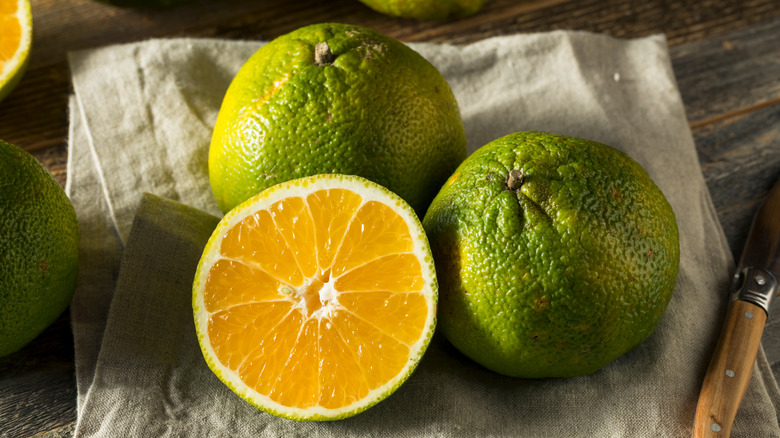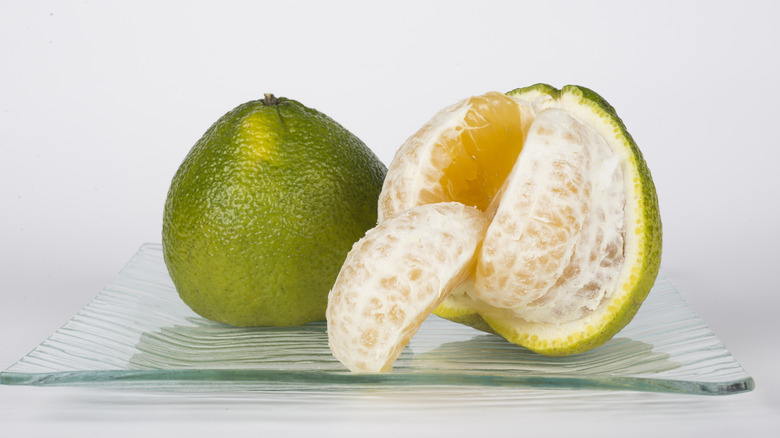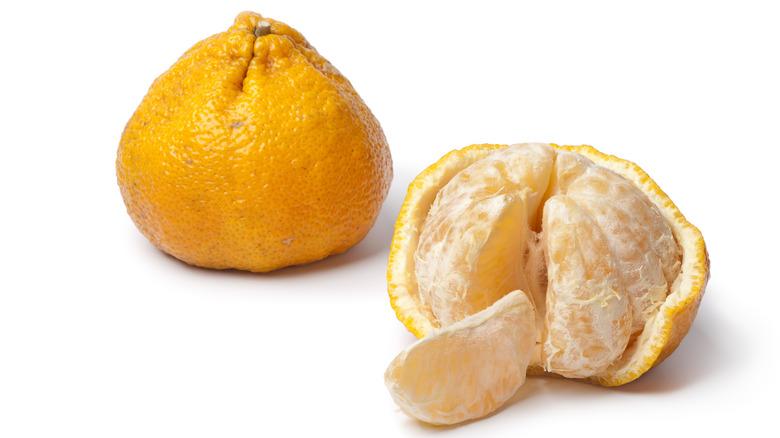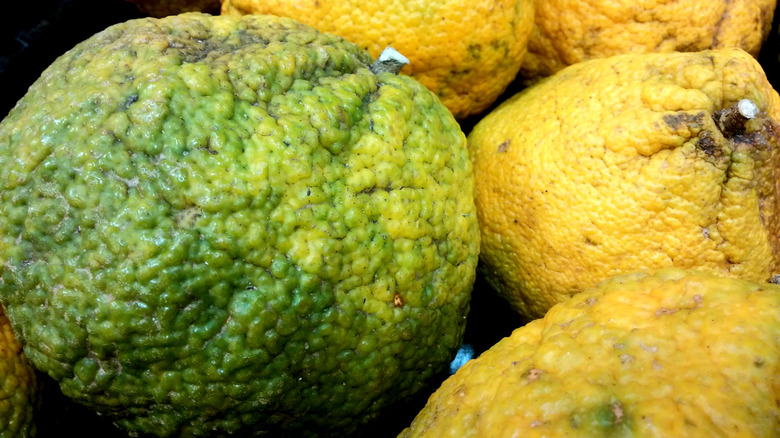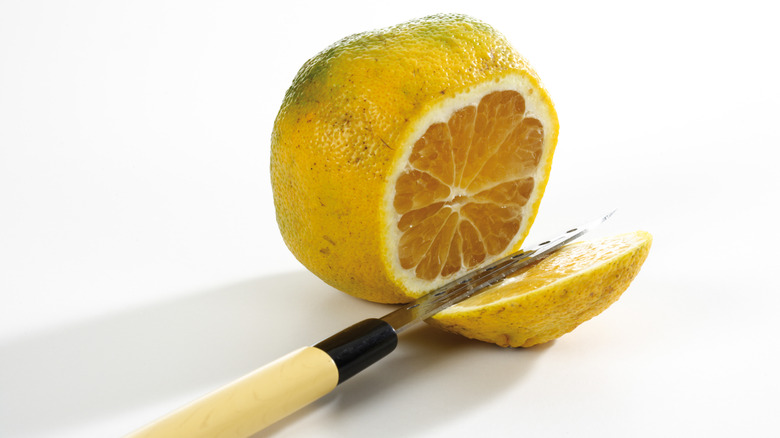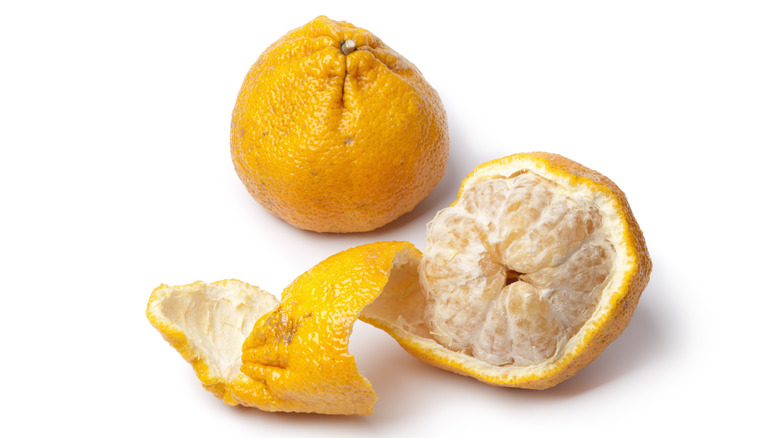Ugli Fruit Deserves Its Time In The Limelight
There are many fruits that have less than favorable names, take for example noni — which is also known as the vomit fruit, or salak — which more popularly goes as snake fruit thanks to its spikey, scale-filled skin. But few fruits have been named as savagely as the ugli fruit. Part of the Rutaceae family and botanically classified as Citrus reticulata x paradisi, ugli fruits are tangelos that are a cross between Seville oranges, grapefruits, and tangerines.
The hybridized ugli fruit was accidentally discovered as a chance seedling growing in the wild near Brown's Town in Jamaica and was first planted by a man named F. G. Sharp at his Trout Hall estate in 1914. By 1934, his son G.G.R. Sharp had exported the first commercial batch of ugli fruits, which were then known as the exotic tangelo from Jamaica, under his company Cabel Hall Citrus Limited — the only exporter of ugli fruit at the time. When the demand for the fruit grew, an importer came knocking on the Sharp family's door, and the fruit found its new moniker. Referencing the wrinkly, patchy, and mottled skin of the fruit, the buyer asked Sharp for "more of that ugly fruit" (via Cable Hall). Ugly was changed to ugli, and the new name was trademarked by the company that made ugli both the name of the fruit and the brand that sold it. Don't let its appearance fool you, however — because an ugli fruit is tastier than its name would have you believe!
What is ugli fruit?
Ugli fruits got their moniker due to their appearance and, as such, are distinctly identifiable by their wrinkly skins. The large citruses have thick, rough, and leathery skins that are far from perfectly shiny. They come specked with lumps, creases, scars, and patches of colors that range from green to yellow and orange. Slightly bigger in size than a grapefruit, ugli fruits can have a diameter as large as 15 centimeters and — unlike round oranges, grapefruits, and tangerines — ugli fruits are shaped like teardrops with oval tops and flat bottoms.
While the skin of the ugli fruit ranges in color and is filled with blemishes, the flesh of the fruit is the very opposite. The insides of the fruit usually contain 10 to 12 orange-yellow colored segments encased in dense white membranes called the pith, with little to no seeds to go with it. Ugli fruits are also very fragrant and usually perfume the air with a mellow lemony scent.
What does ugli fruit taste like and how can you eat it?
Ugli fruit's flavor is a stark contrast to its monstrous appearance — it tastes like the combined flavors of the citrus fruits from which it is made; that is, it is sweet and fruity with a hint of sour tang. An ugli fruit is sweet like a tangerine with a honey-like sugariness to it — but more sour than an orange and noticeably less bitter than a grapefruit. Because of its sweet and tart flavors, an ugli fruit lends itself well to both sweet and savory applications. The fruit can be used as a breakfast topping, turned into marmalade, added as flavoring to desserts, or even used for its citrusy freshness in sauces meant for meat or seafood-based dishes.
The pulp of an ugli fruit is soft, succulent, and aqueous, with a texture so tender that the citrus collapses into a juicy mess even as you try to rip the flesh from its pith. This is why ugli fruits are excellent when sliced into two halves with their skins still intact and eaten plain with a spoon as you would a grapefruit. Alternatively, you can eat it as any other citrus fruit since its skin can be pulled off the flesh very easily with bare hands, and it practically contains no seeds. Ugli fruits are excellent when juiced and added to cocktails or refreshing beverages as well. The fruit also pairs well with a drizzle of sherry and Kirsch, and it is delicious when caramelized with sugar and spices.
How does ugli fruit grow and where can you buy it?
Ugli fruits grow on 15 to 20-foot-tall evergreen trees in tropical, sunny areas and need considerable amounts of water in well-draining soil to thrive. The trees don't do well in cold and frosty climates and fall in zone 10 of the United States Department of Agriculture's hardiness zones. Although ugli fruits can technically be grown from seeds like any other fruit, the best way to ensure that the hybrid fruit grows to its true self is to graft it as hybrids sometimes run the risk of sterile offspring.
Ugli fruit is a trademark of Trout Hall Ltd., which has reserved one-third of its 3,000-acre Trout Hall estate in Jamaica for these tangelos. It then exports the fruits to several parts of the world, including all of Europe, the U.K., the U.S., and Canada – where the sole importer is the Florida-based company Unity Groves. Florida and California also tried to grow ugli fruits in the 1950s, but, sadly, most of these plants were ruined except for a handful that were saved for home growing. While ugli fruits are now grown in other parts of the world including Florida, they are primarily cultivated in Jamaica and exported to supermarkets and specialty stores.
How to pick ripe ugli fruits and store them properly
Ugli fruits are usually in season between winter and spring with summer and fall marking the off-season. As such, you should start seeing these tropical citruses pop up at grocery stores between November and May — though they may still be available from July to September depending on the weather conditions where they are grown.
Ugli fruits are only harvested once they are fully ripe, which means they are ready to be eaten as soon as they are plucked off the branch, so don't be fooled if the fruit's skin still has patches of green; it often retains that hue despite ripening. While going home with a batch of unripe ugli fruits is highly unlikely, there are ways to ensure that you pick the most flavourful of these sweet and tangy citrus fruits. The fruit's appearance may be considered ugly but the scars, wrinkles, and blemishes are signs of a tastier flesh waiting inside. In general, the uglier and older an ugli fruit looks — with skin that seems deflated and loose — the more flavourful the fruit will be.
Once you have your ugli fruits, they should stay fresh for five days when kept unpeeled at room temperature. Alternatively, you could also extend their shelf life by two weeks by refrigerating them. If the fruit's thick skin falls apart a little too easily under your thumb, consider your ugli fruit overripe and spoiled.
Nutritional information about ugli fruit
An ugli fruit's unique flavor profile is reason enough to eat it, but the fruit also comes with important nutrients and health benefits. A 100-gram serving, which is merely half an ugli fruit, makes up for 90% of the daily recommended vitamin C intake. Adequate consumption of this vitamin may prevent chronic diseases like cancer and type 2 diabetes as well as boost collagen production (via Healthline). Half an ugli fruit packs in 47 calories, making it an excellent low-calorie food to snack on, and it also has small amounts of fiber, folate, potassium, and calcium.
Ugli fruits contain flavonoids like naringenin, which is an excellent antioxidant and has impressive anti-inflammatory properties. Although more trials are needed to study the full potential of the flavonoids present inside ugli fruits in humans, a 2018 study published in Reports of Biochemistry and Molecular Biology found that naringenin did reduce liver damage in mice.
The only thing to be cautious of when eating this hybrid fruit is that a part of it comes from a strain of grapefruit — which means ugli fruits can also have the same furanocoumarins that are present in grapefruits. These compounds don't react well with certain medications, such as those for the heart and anxiety. For anyone taking medication regularly, it's best to speak to a medical professional before eating a sweet, tart, and juicy ugli fruit.

